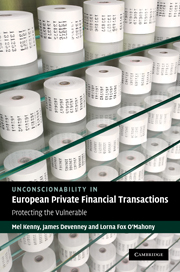Book contents
- Frontmatter
- Contents
- List of contributors
- Introduction: conceptualising unconscionability in Europe
- PART I Conceptualising unconscionability
- PART II Conceptualising unconscionability in financial transactions
- 8 Usury and the judicial regulation of financial transactions in seventeenth- and eighteenth-century England
- 9 Protection of the vulnerable in financial transactions – what the common law vitiating factors can do for you
- 10 Borrowers as consumers: new notions of unconscionability for domestic borrowers
- 11 Conceptualising and understanding fairness: lessons from and for financial services
- 12 Open the box: an exploration of the Financial Services Authority's model of fairness in consumer financial transactions
- 13 Conceptualising unconscionability in the context of risky financial transactions: how to converge public and private law approaches?
- 14 Conceptualising unconscionability in the post-Soviet era: the Lithuanian case of legal transplants
- 15 Bank loan contracts in Polish law: the legal position of the borrower
- 16 Financial contracts and ‘junk title’ purchases: a matter of (in)correct information
- 17 Kickback payments under MiFID: substantive or procedural standard of unconscionability?
- 18 Unfairness under the Consumer Protection from Unfair Trading Regulations 2008
- Conclusions
- Index
- References
17 - Kickback payments under MiFID: substantive or procedural standard of unconscionability?
from PART II - Conceptualising unconscionability in financial transactions
Published online by Cambridge University Press: 06 August 2010
- Frontmatter
- Contents
- List of contributors
- Introduction: conceptualising unconscionability in Europe
- PART I Conceptualising unconscionability
- PART II Conceptualising unconscionability in financial transactions
- 8 Usury and the judicial regulation of financial transactions in seventeenth- and eighteenth-century England
- 9 Protection of the vulnerable in financial transactions – what the common law vitiating factors can do for you
- 10 Borrowers as consumers: new notions of unconscionability for domestic borrowers
- 11 Conceptualising and understanding fairness: lessons from and for financial services
- 12 Open the box: an exploration of the Financial Services Authority's model of fairness in consumer financial transactions
- 13 Conceptualising unconscionability in the context of risky financial transactions: how to converge public and private law approaches?
- 14 Conceptualising unconscionability in the post-Soviet era: the Lithuanian case of legal transplants
- 15 Bank loan contracts in Polish law: the legal position of the borrower
- 16 Financial contracts and ‘junk title’ purchases: a matter of (in)correct information
- 17 Kickback payments under MiFID: substantive or procedural standard of unconscionability?
- 18 Unfairness under the Consumer Protection from Unfair Trading Regulations 2008
- Conclusions
- Index
- References
Summary
Outline
In this chapter, we discuss problems related to kickback payments in financial transactions. After a short introduction into the nature of kickback payments, we identify these problems and briefly address solutions that have been discussed under German law (section 2). We then turn to EC legislation, in particular Directive 2004/39/EC on Markets in Financial Instruments (the MiFID Directive) and subsequent instruments that are meant to elaborate this Directive and demonstrate the way in which the Directive addresses kickback payments as ‘inducements’ (section 3). While the new rules have been the subject of heated debate between the banks and consumer groups, the German implementation of EC legislation is, at first glance, scandalously bank-friendly (section 4). In contrast, we propose to use findings from research on behavioural finance to interpret the law correctly and to propose a stricter reading of the EC rules on inducement and implementing legislation (section 5). We also discuss whether more stringent national rules on kickback payments are still allowed following the adoption of the MiFID Directive (section 6). Finally, we return to the general issue of deciding between procedural and substantive mechanisms to protect customers of investment services against unconscionable transactions (section 7).
Kickback payments in financial transactions and related problems
Kickback payments
First of all, what are kickback payments? Here we are looking at investors who use a bank or any other investment firm (for simplicity's sake, we will refer to banks) to get advice with regard to investment decisions – such as the purchase of stocks, shares in investment funds or other investment instruments.
Information
- Type
- Chapter
- Information
- Unconscionability in European Private Financial TransactionsProtecting the Vulnerable, pp. 326 - 349Publisher: Cambridge University PressPrint publication year: 2010
